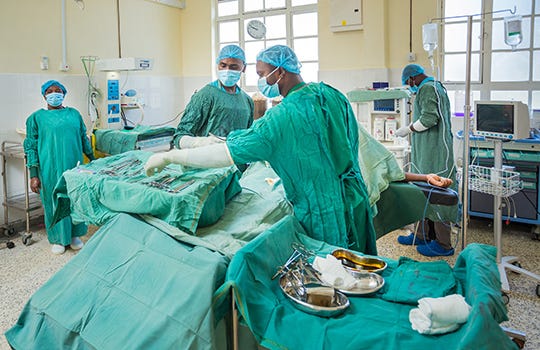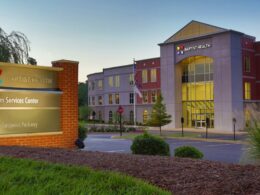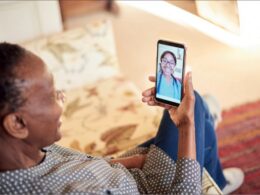Teaching and learning through Zoom has helped surgeons in Ukraine respond to the challenges of war, writes Jo Best.
Digital technology will continue to change the face of surgery around the world-but there are challenges to overcome
BMJ
Jo Best, freelance writer and doctor
03 May 2022
When Russia’s invasion of Ukraine began in February, medics and surgeons across Europe and beyond reached out to support their colleagues in the country.
As well as answering calls for equipment and resources for combat injuries, surgeons from outside Ukraine turned to videoconferencing platforms such as Zoom to share expertise with doctors caught up in the conflict.
Henry Marsh, a neurosurgeon and author who has been operating in Ukraine since the 1990s, was one of the surgeons offering advice over Zoom.
While 25% of battlefield deaths are because of head injuries, “the actual acute management of head injuries in a war zone is limited.
While 25% of battlefield deaths are because of head injuries, “the actual acute management of head injuries in a war zone is limited.
You don’t carry out major brain surgery,” Marsh told a Royal Society of Medicine event in April. “If somebody comes in in a coma with a penetrating injury, you triage them to have no treatment.
“What neurosurgery is done in a battlefield is non-urgent, it’s done within 24 hours to repair superficial open injuries. It’s very different from civilian practice.”
“What neurosurgery is done in a battlefield is non-urgent, it’s done within 24 hours to repair superficial open injuries. It’s very different from civilian practice.”
From webinar translation to bunker
Marsh’s Zoom discussions with Ukrainian doctors were part of a March webinar arranged by the David Nott Foundation, an organisation set up by the eponymous surgeon to train doctors in conflict affected areas.
The course was a condensed version of the foundation’s five day Hostile Environment Surgical Training programme.
The webinar, attended by more than 570 Ukrainian doctors, 1 aimed to provide a crash course on how to deal with war injuries across subjects including burns, plastics, triage, and damage control.
The webinar, attended by more than 570 Ukrainian doctors, 1 aimed to provide a crash course on how to deal with war injuries across subjects including burns, plastics, triage, and damage control.
In the weeks that followed the invasion, the European surgical not-for-profit AO Foundation also ran sessions for doctors over Zoom. 2
The sessions were set up after discussions with AO’s Ukrainian chair. “He explained that Ukrainian surgeons are not experienced in treating the kinds of war injuries they were now facing,” Anja Sutter, senior project manager events and relations at the foundation, tells The BMJ.
The Zoom sessions were attended by up to hundreds of doctors at a time, and continued even in difficult circumstances.
“Sometimes our translator, a faculty member from AO Trauma Ukraine, had to go to a bunker because of a bomb alarm during a live session and another faculty had to take over for a time,” Sutter says.
The sessions focused on dealing with war injury and trauma, with surgeons from eight countries contributing to over 40 hours of teaching.
Recordings of the sessions remain available on the AO website for doctors to access whenever they want.
The sessions focused on dealing with war injury and trauma, with surgeons from eight countries contributing to over 40 hours of teaching.
Defining and refining the advice
Mansoor Khan, a consultant surgeon with extensive experience in war zones, says that, as conflicts evolve, the surgical support that is provided online needs to be tightly focused on the needs of those on the ground.
“The first thing you have to ask is, what do you need, in terms of education and resources?” he tells The BMJ.
“The first thing you have to ask is, what do you need, in terms of education and resources?”
“These guys are seasoned surgeons. Ukraine’s been in conflict with Russia for a number of years now, so they’ve got experience. What we need to try and find out is what they require, not what we think they need to learn.”
At the start of the conflict, doctors outside Ukraine used videoconferencing platforms as a way of sharing broad based knowledge with as many of their colleagues in the country as possible.
Now, surgeons in Ukraine are also using other digital tools to get advice on complex cases.
Now, surgeons in Ukraine are also using other digital tools to get advice on complex cases.
“Telemedicine is not only about showing people what to do, it’s also using tools like WhatsApp,” Khan says.
Through such messaging services, European surgeons are now doing quick case reviews and giving highly targeted advice to their Ukrainian colleagues.
“Within three sentences, you can give them a plan.”
“Telemedicine is not only about showing people what to do, it’s also using tools like WhatsApp,” …

Existing technology, future learning
Using videoconferencing to support doctors overseas, or in areas with increased need or low resources, is not new.
Médecins Sans Frontières uses secure videoconferencing for clinical case discussions, clinical supervision, patient consultations, and training, for example.
Using videoconferencing to support doctors overseas, or in areas with increased need or low resources, is not new.
Médecins Sans Frontières uses secure videoconferencing for clinical case discussions, clinical supervision, patient consultations, and training, for example.
Throughout the covid-19 pandemic, UK surgeons have been using platforms such as Zoom and Teams to keep up with colleagues for teaching, conferences, collaboration, and team meetings.
The spread of videoconferencing and its ability to support geographically dispersed teams could mean teaching and learning nationally and internationally could play a greater role in surgical practice in future.
“It enables teaching and training to become more accessible to many more people,” says Richard Kerr, consultant neurosurgeon and council member of the Royal College of Surgeons of England.
“Even in this country, part of the medical curriculum is seeing and being exposed to surgical procedures.
You can imagine a time perhaps when two or three units will club together, so that trainees in each of those units can see what’s happening in the other units.
They can dial in to operations when there may be surgeons that are doing particular procedures.
“This is going to increase the exposure, and therefore the experience, of trainees.”
Improving caesarean section safety in Kenya
Several new digital platforms aim to build on traditional videoconferencing to allow surgeons to collaborate on cases in real time with functionality that replicates hands-on practice.
Proximie, which combines videoconferencing with technologies such as augmented reality, enables surgeons in one location to see multiple views of a theatre in another.
They can mark up patients and give input into the case in real time as it progresses.
Proximie, which combines videoconferencing with technologies such as augmented reality, enables surgeons in one location to see multiple views of a theatre in another.
They can mark up patients and give input into the case in real time as it progresses.
In Makueni county, Kenya, a project is underway to use this technology to improve the safety of caesarean sections.
The county, which has a population of over 900 000, has just three obstetrics and gynaecology consultants working across two hospitals, with most caesarean sections performed by junior doctors known as medical officers.
In Makueni county, Kenya, a project is underway to use this technology to improve the safety of caesarean sections.
As part of the Obstetric Safe Surgery project, supported by organisations including John Hopkins University affiliate Jhpiego, Proximie technology has been rolled out to five hospitals in the county with the aim of improving maternal and newborn outcomes.
Using the technology, consultants mentor medical officers through simulated caesarean sections, as well as provide training on infection prevention, use of the World Health Organization’s surgical safety checklist, administration of anaesthesia, and care of newborns immediately after delivery.
The consultants are also starting to assist remotely with elective cases, with Proximie using four views of the theatre-the entire theatre, the operation site, anaesthesia, and the infant resuscitation area-to give an overview of the operation as it happens.
Those watching remotely can annotate and highlight areas of the surgical field for those in the theatre.
Privacy, scheduling, and connectivity concerns
Before the technology can be used more widely, there are problems to overcome. Patients will need to be convinced of the privacy of the technology: Doris Mbithi, medical superintendent of the Mother and Child Hospital in Makueni county and one of its consultants, notes that some patients are concerned footage will end up on the internet.
And setting up a session, which must be scheduled in advance by an IT specialist, will need to be made quicker and simpler.
Broadband connectivity is also a problem.
“That has been our main challenge,” Mbithi says. “Sometimes you schedule a live case and the consultant joining virtually is not able to continue guiding because the internet keeps disconnecting.”
And setting up a session, which must be scheduled in advance by an IT specialist, will need to be made quicker and simpler. Broadband connectivity is also a problem.
Within the coming months-assuming these challenges can be overcome-the technology will progress from being used for training to allowing consultants to advise on emergency cases happening in facilities hours away.
“It’s a good technology for mentorship.
It’s my wish that it can also work for emergency cases where a surgeon is stuck in a small facility and then you can log in and assist them to save a life,” Mbithi says.
Within the coming months-assuming these challenges can be overcome-the technology will progress from being used for training to allowing consultants to advise on emergency cases happening in facilities hours away.

Telesurgery hopes and challenges
In the future it’s likely that remote surgical collaboration technology will evolve to the point where surgeons in one location use surgical robots to operate on patients in another.
A handful of such remote surgeries have already been performed on cadavers, animal models, and humans, 3 including the reported insertion of a deep brain stimulator in a patient with Parkinson’s disease 4 by a surgeon controlling a robotic arm from a city 3000 km away.
In the future it’s likely that remote surgical collaboration technology will evolve to the point where surgeons in one location use surgical robots to operate on patients in another.
The spread of such remote telesurgery will depend on the uptake of two technologies: surgical robotics and 5G networks.
Such mobile networks will reduce latency-the delay between when data are sent and received-to under 1 millisecond.
At the same time, it will increase download speeds to a theoretical peak of over 1 gigabits per second.
Both are notable steps up from what is currently available through 4G networks and are necessary to allow the surgeon and robot to operate in an as near real time environment as possible, without any lag between the surgeon’s and the robot’s movements.
The spread of such remote telesurgery will depend on the uptake of two technologies: surgical robotics and 5G networks
The hope is that telesurgery will eventually allow hospitals in remote or low resource areas access to surgeons from elsewhere to perform operations.
It is, however, a promise not set to be realised in the short term.
Of those 5G networks currently up and running, only a small percentage are in developing areas, and the vast majority of 5G networks worldwide are not of the type that could support remote surgery, according to Jason Leigh, manager of 5G and mobility research at technology analysts IDC.
“The areas that could most benefit from surgical virtual reality support and robotic telesurgery are also those that are lagging in 5G deployment.”
Of those 5G networks currently up and running, only a small percentage are in developing areas, and the vast majority of 5G networks worldwide are not of the type that could support remote surgery,
Originally published at https://www.bmj.com on May 3, 2022.
Names mentioned
Henry Marsh, a neurosurgeon and author
Richard Kerr, consultant neurosurgeon and council member of the Royal College of Surgeons of England.
Anja Sutter, senior project manager events and relations at the foundation
Mansoor Khan, a consultant surgeon with extensive experience in war zones,
Doris Mbithi, medical superintendent of the Mother and Child Hospital in Makueni county
Jason Leigh, manager of 5G and mobility research at technology analysts IDC.
David Nott Foundation












